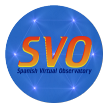Observational Star Templates
Stellar templates  | ATLAS A | | | All Spectral Type LAMOST Spectra Library (ATLAS). Group A. This group contains 5584 spectra covering spectral types from O- to M-type and some special types such as A supergiant, blue horizontal-branch, and carbon stars. All of the spectra have absolutely calibrated fluxes
|
|  | ATLAS T | | | All Spectral Type LAMOST Spectra Library (ATLAS). Group T. This group contains 1118 spectral templates averaging over spectra with similar stellar parameters from ATLAS-A. It smooths out some special features in the individual spectra and can be used as a "standard" atlas of stellar spectra.
|
|  | Bayo et al, M types from Collinder 69 | | | Complete M spectral type sequence for a sample of confirm young sources (members
of Collinder 69, ~5-20 Myr). Be aware that most spectra are not flux calibrated.
|
|  | Elodie v3.1 | | | ELODIE v3.1 library is an updated release of the library published in 2001 and 2004 by Prugniel & Soubiran. The library includes 1959 spectra of 1388 stars obtained with the ELODIE spectrograph at the Observatoire de Haute-Provence 193cm telescope in the wavelength range 390 to 680 nm.
|
|  | HST/STIS Library | | | HST Low Resolution Stellar Library. It includes 513 fully reduced stellar spectra, with a broad spectral range, fluxed, dereddened, and cross-correlated to zero velocity.
|
|  | Indo-US | | | The Indo-U.S. Library of Coudé Feed Stellar Spectra. This spectral library consists of spectra for 1273 stars obtained with the 0.9m Coudé Feed telescope at Kitt Peak National Observatory. The spectra have been obtained at an original dispersion of 0.44 Angstroms/pixel, at a resolution of ~1 Angstroms FWHM.
|
|  | Keck LRIS spectra of late-M, L and T dwarfs | | | These spectra were obtained between 1997 and 1999; they are all flux calibrated and generally span the wavelength range 6000-10,000 A. Spectral types are on the Kirkpatrick et al system as defined in Kirkpatrick et al ApJS, 77, 417 (1991 - for M dwarfs) and Kirkpatrick et al ApJ 519, 802 (1999 - L dwarfs). While not all of these stars are primary spectral standards, they are all bright and should provide an adequate reference sequence.
|
|  | Kesseli et al. | | | An empirical library of stellar spectra created using spectra from the Sloan Digital Sky
Survey�s Baryon Oscillation Spectroscopic Survey (BOSS).
|
| |  | MILES | | | ~1000 stars spanning a large range in atmospheric parameters. The spectra were obtained at the 2.5m INT telescope and cover the range 3525-7500 � at 2.5 � (FWHM) spectral resolution
|
|  | MUSE 1d Spectral Library | | | MUSE Spectral Library (MSL), consisting of 35 high-quality spectra of stars covering the Hertzsprung�Russell diagram, and verified the continuum shape of our spectra with synthetic broadband colours.
|
|  | STELIB | | | The objective of the STELIB Stellar Library is to build an homogeneous library of stellar spectra in the visible range (3200 to 9500A), including stars of all spectral types, luminosity classes and metallicity that can be observed from the ground with the current instrumentation.
|
|  | The NIRSPEC Brown Dwarf Spectroscopic Survey | | | The Brown Dwarf Spectroscopic Survey (BDSS), established in 1998 by Dr. Ian McLean in collaboration with Dr. J. Davy Kirkpatrick at IPAC, is designed to study near-infrared moderate-to-high resolution spectra for a large sample of low-mass stars and sub-stellar mass objects in the M and newly defined L and T dwarf classes.
|
| |  | UVES-POP | | | Re-calibrated version of the UVES-POP stellar spectral library. The original library was released in 2003 (Bagnulo et al., 2003) and contained optical spectra of about 400 stars with the resolving power of R=80,000 collected with the UVES spectrograph at ESO VLT. The new release consists of spectra of 406 stars, has the wavelength coverage 3200 Å < λ < 10250 Å
|
|  | UVES/VLT | | | A high-resolution (R = 40000), flux calibrated, optical+NIR (6400-8900A) library of late type subdwarfs, from late K to M9.5, obtained with UVES at VLT. The library is described in Rajpurohit et al. (2014)
|
| |
 |
|


